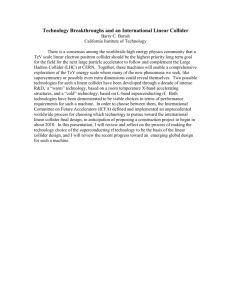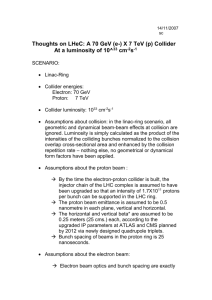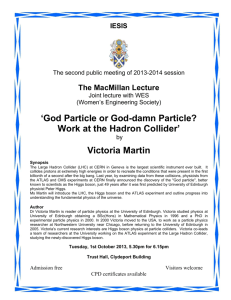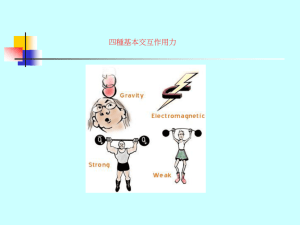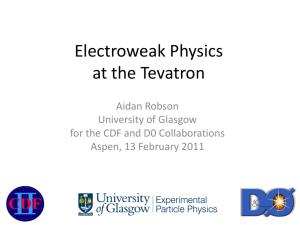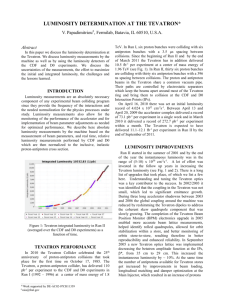P5 Report on Running of the Tevatron and PEP-II and Future
advertisement
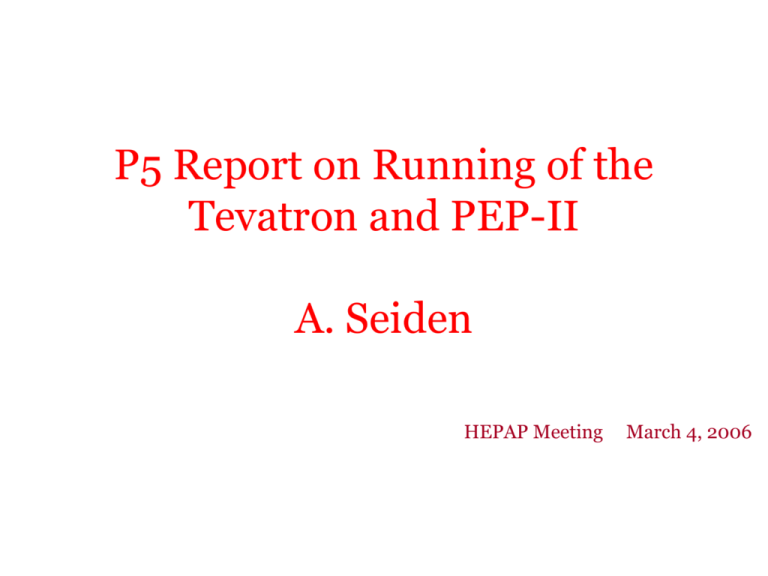
P5 Report on Running of the Tevatron and PEP-II A. Seiden HEPAP Meeting March 4, 2006 P5 Membership List Particle Physics Project Prioritization Panel (P5) Abe Seiden (UCSC) Chair Karl Jakobs (University of Freiburg) Hiroaki Aihara (University of Tokyo) Jay Marx (LBNL) Andy Albrecht (UC Davis) Ann Nelson (U. of Washington) Jim Alexander (Cornell) Harrison Prosper (Florida State U.) Daniela Bortoletto ( Purdue) Tor Raubenheimer (SLAC) Claudio Campagnari (UCSB) Steve Ritz (NASA) Marcela Carena (FNAL) Michael Schmidt (Yale) Fred Gilman (Carnegie Mellon University) (ExOfficio) Mel Shochet (U. of Chicago) Dan Green (FNAL) JoAnne Hewett (SLAC) Harry Weerts (Michigan State U.) Stanley Wojcicki (Stanford U.) Boris Kayser (FNAL) 2 Charge The charge to the P5 HEPAP subpanel asks the subpanel to examine the plan for continued running of the major accelerator facilities now operating. Current planning calls for the PEP-II B-factory at the Stanford Linear Accelerator Center to be operated until the end of FY2008 and the Tevatron collider at Fermilab through FY2009. We are asked to assess what factors or considerations might lead to stopping B-factory operations one year, or two years earlier than planned? When would we be in a position to make such a determination and what information would be needed? Similarly, for the Tevatron collider, what factors or considerations might lead to stopping operations one year, or two years earlier than now planned? What might lead to running longer than now planned? Again, when would we be in a position to make such a determination and what information would be needed? The ending of data taking with the Tevatron collider and PEP-II will make room for the funding of new initiatives. However it is also essential to fully exploit the discovery potential of these world-class facilities. Therefore it is crucial to evaluate when the significant resources now invested in the operation of these facilities will have a greater scientific impact if they were to be deployed otherwise. 3 Process To provide a response to the charge we held three meetings to gather the appropriate information. The first meeting on September 8 and 9, near Washington D.C., provided an opportunity to hear from the DOE and the NSF about both our charge and budget constraints for the field, to hear about parts of the program other than the Tevatron collider and PEP-II, and to discuss issues related to addressing our charge. The other two meetings were at Fermilab on September 12 and 13 and at SLAC on October 6 and 7. At these meetings we heard about overall long-term laboratory plans, as well as the accelerator status, physics potential, and manpower and collaboration issues for the Tevatron collider and PEP-II, respectively. We also had the opportunity at each laboratory for discussion with members of the international teams involved in these experiments, the program leaders, and the laboratory management. 4 Executive Summary The Tevatron collider and PEP-II accelerator are rapidly accumulating more data. The existing data sets will be doubled and then doubled again by the currently planned stopping dates. Each doubling of the data allows significantly more physics as both of these programs seek to discover how nature works at a deeper level. Early termination would reduce the physics that will come from these world-leading programs. With the material presently before P5, we see no reason to terminate the operation of either the Tevatron or PEP-II earlier than planned. However we have not yet studied in detail other HighEnergy Physics projects that could be started if funds were available. P5 will be looking at the full U.S. particle physics roadmap in 2006. We plan to revisit the issue of the last year of running for the Tevatron and PEP-II programs in the context of a full roadmap. Input from a number of HEPAP subpanels presently looking at different aspects of the program will be an important component of our planning exercise in 2006. 5 Tevatron Integrated Luminosity Tevatron integrated luminosity projections, corresponding to different rates of accumulating anti-protons. From the presentation of D. McGinnis to our committee. 6 PEP-II Integrated Luminosity End of Fiscal Year Total PEP-II Projection Delivered (fb-1) Yearly Luminosity Increment (fb-1) FY04 256 117 FY05 311 55 FY06 470 159 FY07 653 183 FY08 1004 351 Expected PEP-II Delivered Integrated Luminosity. 7 General Summary 1) 2) 3) 4) The physics collaborations are producing many front-line physics results and are exploring a window of opportunity to discover new physics. They are also functioning efficiently. Competition between collaborations (CDF and DO at the Tevatron and between BaBar and Belle) not only provides crosschecks of difficult measurements but also has led to novel analysis techniques and exploitation of new methods for making important measurements. The accelerators are performing extraordinarily well and pushing the performance frontier with new ideas and techniques. These programs provide models for international collaboration, including the sharing and integration of computing resources across continents. 8 Tevatron Physics Summary The Tevatron collider, with its continued position at the energy frontier, will remain for the next few years an excellent window onto possible new physics. With ever increasing luminosity, the CDF and DO collaborations are the dominant experiments with the potential to discover new physics through direct searches. Well-motivated examples include Higgs bosons (key to the understanding of mass), supersymmetric particles (among them the lightest supersymmetric particle, which provides an attractive candidate for dark matter), new gauge bosons (which would signify entirely new interactions in nature), excited fermions (which would indicate a whole new layer of building blocks for matter), and signals for extra dimensions (which are predicted by string theory and could radically change our understanding of gravity). In addition, precise measurements of the top quark and W boson masses provide incisive tests and constraints on our picture of the electroweak interactions. Once we discover the source of electroweak symmetry breaking, for example Higgs bosons, the precision measurements will serve to constrain the physics picture needed to understand the new phenomena. Assuming that our simplest model is sufficient to describe the essentials of electroweak symmetry breaking, the latest values of the masses of the top quark and W boson point to a relatively light Higgs boson. The Tevatron also provides important measurements for the Bs system, where mixing and rare leptonic decays provide important tests of our understanding of flavor processes complementary to the B-factory measurements. With the data expected in the next few years, the Bs measurements will confront directly the Standard Model predictions, allowing searches for new physics contributions. 9 PEP-II Physics Summary The PEP-II accelerator is routinely running at approximately five times the design averaged luminosity, allowing a much richer physics program for BaBar than originally planned. The BaBar collaboration is making world-leading measurements of the three angles of the unitarity triangle, in some cases using recently invented techniques, as well as the Vcb and Vub CKM matrix elements. The complete set of measurements represent an unprecedented check of the coupling of quark-flavors to the W boson, parameterized in the Standard Model by the CKM matrix. These charged current couplings arise from electroweak symmetry breaking, as do the various quark masses. In addition, it has proven possible to do a broad set of measurements for processes where photons or gluons accompany transitions between the b quark and the strange or down quark. These transitions are between quarks that have different flavors but the same electric charge. Such transitions arise in the Standard Model only from rare virtual short-distance processes. Through the comparison to Standard Model predictions, these measurements both probe for new physics as well as serve to constrain any postulated new physics scenarios. At present several important measurements show deviations from their expected Standard Model values but require smaller errors to reach definitive conclusions. All of the most interesting PEP-II measurements are statistics limited and therefore increasing the total integrated luminosity will allow a much more definitive check of the physics. Running through 2007 is required to double the data taken through FY 05. Running through 2008 is required to make full usage of the machine improvements that are scheduled for the summer of 2006, allowing an additional 50% increase in integrated luminosity, resulting in a factor of four increase in integrated luminosity compared to the data sample presently analyzed. 10 Recommendations We will be making a full roadmap later this fiscal year. We are deferring making final recommendations for the last year of running of the Tevatron and PEP-II facilities till after we can include the final year in a full updated roadmap. The question we propose looking at is the potential scientific impact of various options as well as the schedule and urgency for new initiatives. We therefore recommend that P5 revisit the issue of the final year of running, in the context of a better-understood roadmap, in Spring 2006 for PEP-II and Spring 2007 for the Tevatron collider. In addition to a better understanding of opportunities for new projects we propose looking at several issues for these programs that can be better evaluated at a future date. 11 Recommendations These are, for the Tevatron collider: The integrated and projected luminosity for this program, the status of the LHC, the manpower situation for the Tevatron program, the physics picture revealed by earlier Tevatron running, and any new physics results coming from other parts of the program. The issue of whether any running beyond 2009 is warranted should also be looked at. For PEP-II the issues are: The achieved and projected luminosity of both PEP-II and KEKB in Spring 2006 and the updated values for the key measurements planned by these projects, in particular the status of the hint of New Physics in the CP asymmetries as measured in gluonic penguins. 12 Recommendations We strongly encourage the DOE to engage those agencies that fund the major non-US collaborating groups participating in the Tevatron and PEP-II programs in a discussion of issues and timetables for the running of these facilities. Lines of communication with these foreign funding agencies should be strengthened, recognizing that they are partners who have made very significant investments and played a major part in the success of both of these programs. A very important issue at stake is the reputation and credibility of the US in international HEP partnerships. 13 Supersymmetric Higgs tanβ versus mass of the pseudo-scalar Higgs boson, A, in the MSSM. Shown are the LEP exclusion region (blue), the CDF di-τ analysis exclusion region pink), the extension of the exclusion region by DO bbb analysis (green), and the future expected exclusion region for the di-tau channel at the Tevatron with 1, 4 and 8 fb-1 of luminosity. 14 Standard Model Higgs Constraint Current status of precision measurement constraints on the Higgs mass. 15 Bs Physics Measurements The collider program includes an important set of measurements on the Bs system. These include mixing, lifetimes, lifetime differences of the two mass eigenstates, and the decay to the m+m- final state. 16 Bs Physics Measurements DG s 0.23 0.08ps -1 DG s 0.330.09 0.11 Gs 1 1.4050.043 0.047 ps Gs Constraints on Bs Decay Widths. From the combined fit, a nonzero lifetime difference has been observed at about the 3s level, with a central value larger than the theoretical expectation of DGs/Gs = 0.12 0.06. In addition, current theoretical expectations are that the total decay width for the Bs and the Bd should be equal to approximately 1%; however 1/Gd = 1.528 0.009 ps. 17 PEP-II Physics Program General Considerations: The principal goal of the B physics programs at PEP-II and KEKB has become the search for new physics beyond the Standard Model. These programs carry out this search by looking for decays, mixing phenomena, or CP-violating asymmetries that, either individually or in combination, cannot be described by the four parameters in the Standard-Model CKM quark mixing matrix. Evidence of new physics could take the form of inconsistent values for a single Standard-Model quantity when this quantity is measured in different ways, or a non-Standard-Model rate for a rare decay, or a nonStandard-Model CP-violating asymmetry in some decay. 18 Theoretical Limitations on Major Observables Measurement (in SM) B K S (β) B ' K S , φ S (β) B ρρ, ρπ, ππ (α) B DK (γ) Bs ψφ (βs) Bs DsK (γ 2 βs ) Vcb K - Vub B Xγ B X B K(*) Theoretical limit ~ 0.2° ~ 2° ~ 1° < 1° ~ 0.2° < 1° ~ 1% Present error 1.3° 5, 10° ~ 13° ~ 20° ~ 2% ~ 5% ~ 10% ~ 5% ~ 5% ~ 5% ~ 10% ~ 20% - Sample of measurements that can be made in B physics for which the theoretical ambiguity in the interpretation is small compared with current experimental errors. 19 Some Precise Comparisons The unitarity triangle. The constraint on and from |Vub/Vcb| (From Silvestrini). 20 Penguin Modes sin(2β) measured in various modes at BaBar and at Belle, assuming these modes are dominated by Standard Model b -> s gluonic penguins. Note these values are generally low compared with the world average measurement of sin(2 β) in b -> c c 21 s modes. Clean Penguin Modes Number of Standard Deviations, World Averages 4.5 4 N Sigma - World Average 3.5 ■ φ + Ks ♦ η' + Ks 3 2.5 2 1.5 1 0.5 0 FY05 FY06 FY0-6 FY07 FY07 FY08 FY08 Status by FY Number of standard deviations of the combined discrepancy of BaBar and Belle with the Standard Model of the CPV asymmetries for the “clean’’ gluonic penguin decay modes, assuming the central world value remains unchanged as more data is accumulated. 22 Hadron Spectroscopy Thanks to the discovery by both Belle and BaBar of a large number of new charmed and charmonium hadrons, some of whose properties challenge and constrain our understanding of nonperturbative QCD, one of the most exciting areas being pursued at both B factories is hadron spectroscopy. Increased statistics would likely result in the discovery of additional states, as well as helping to elucidate the properties of those already discovered. While such spectroscopy does not test the Standard Model, it does illuminate it, allowing us to refine our models for how to approximate QCD in a nonperturbative region. 23 Future P5 has received the new assignment to make a roadmap for the field and recommend priorities among options. Goal is to complete this by the end of this Fiscal Year. Have scheduled meeting in Washington for March 27 and 28 as well as meetings in April at Fermilab and SLAC. We will also be working in the interim. P5 will get an update regarding PEP-II at the April SLAC meeting. 24


